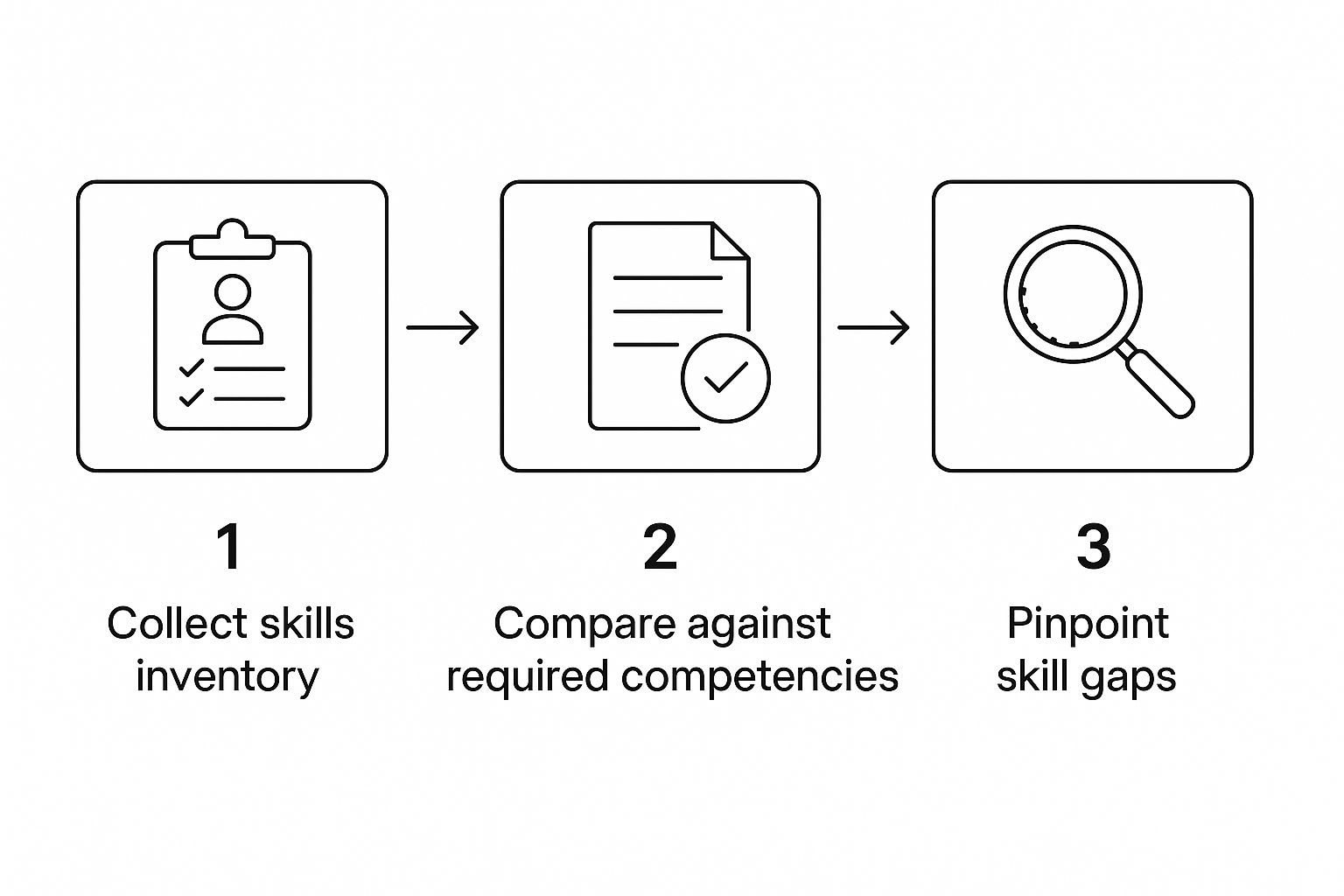A skills gap analysis template is a structured document that helps organisations pinpoint the difference between the skills their workforce currently possesses and the skills they need to achieve their strategic goals. Think of it as a roadmap; it shows you precisely where your team stands and what capabilities you need to build to move forward.
Why a Skills Gap Analysis Matters More Than Ever

Let's be candid, identifying skills gaps can often feel like just another HR task on an already long to-do list. But in today’s market, it represents the critical difference between stagnation and sustainable growth. Ignoring these gaps isn't a passive choice; it has real, tangible consequences that ripple across the entire organisation.
Stalled projects, slipping productivity, and talented people walking out the door are often just symptoms of a deeper problem: a mismatch between the skills you have and the skills you need. This is why forward-thinking organisations are moving beyond guesswork. They’re using a structured approach to turn abstract business goals into a concrete, actionable talent strategy, and a skills gap analysis template is the perfect tool to make that happen.
The True Cost of Neglecting Skills Gaps
When you fail to address skills shortages, you’re creating serious risks that can undermine your competitive edge. The impact is felt right across the business when teams lack the capabilities to perform at their best.
Here’s where it usually hurts most:
- Decreased Productivity: You’ll see employees struggling with new technologies or processes, which inevitably leads to inefficiencies and missed deadlines.
- Lower Employee Morale: Staff can become disengaged or frustrated when they feel ill-equipped to meet expectations. This is a fast track to higher turnover.
- Stifled Innovation: Without the right skills in areas like data analytics, AI, or digital marketing, your ability to innovate and adapt is severely limited.
A skills gap analysis isn't about finding fault. It’s about building a resilient, future-proof workforce. It gives you the hard data you need to make intelligent decisions about training, development, and strategic hiring.
This proactive approach is especially vital in the current economic climate. A recent workforce planning report projects Australia will face a shortfall of around 250,000 skilled workers by 2025 if we stay on the current trajectory. That highlights the sheer scale of the challenge.
This shortage affects a wide range of roles, with the mismatch between available skills and job requirements driving ongoing recruitment difficulties. It makes a skills gap analysis an essential tool for diagnosing and anticipating your workforce's capability needs. You can read the full research about the future skills landscape to get a better sense of what's coming.
By systematically identifying where your team's skills are strong and where they need a boost, you can create targeted development plans that deliver real results. It’s all about building a workforce that’s not only effective today but is also ready for whatever comes next.
Laying the Groundwork for an Effective Analysis

Before you even think about opening a skills gap analysis template, there’s some crucial preparatory work to do. A truly successful analysis is far more than a checklist of skills; it’s about strategically aligning your team’s capabilities with where your business is headed. Getting this right from the start makes all the difference.
The first big decision is about scope. It’s tempting to go big and analyse the whole company, but that can quickly become overwhelming and the results often end up too vague to be useful. In our experience, a more focused approach works best.
Consider starting small:
- A single, high-impact team: Is your cybersecurity team falling behind the latest threats? Zeroing in on them can deliver fast, high-value results.
- An entire department: Perhaps your marketing department is moving towards a more data-centric model. An analysis here can map out the collective skills needed for a smooth transition.
- The whole organisation: This broad scope is really only for massive strategic shifts, like a company-wide digital transformation where almost every role will change.
Kicking off with a pilot team or department lets you iron out any kinks in your process before you roll it out further.
Aligning with Future Business Goals
A good skills gap analysis is forward-looking. It’s not about what you need today; it's about identifying the skills that will get you to your strategic goals next year and in the years to come. You have to ask: what is the business actually trying to achieve?
Let’s say a key business objective is to improve customer retention by 15%. Your analysis should then laser-focus on the skills that support this, like customer journey mapping, data analysis, and proactive communication.
This direct link ensures your training and development efforts contribute straight to the bottom line. It reframes the analysis from a simple HR exercise into a core business strategy. As you identify these needs, don't forget the importance of balancing soft skills and hard skills for success; both are absolutely vital for hitting ambitious targets.
Securing buy-in is less about asking for permission and more about demonstrating value. Present your plan not as an audit of weaknesses, but as a strategic investment in the people who drive the business forward.
Finally, you need your managers and senior leaders on board. Their buy-in is non-negotiable if you want your findings to lead to real change instead of just gathering dust in a spreadsheet.
Frame the analysis as a powerful tool for their success—a way to help them build stronger, more effective teams.
Putting Your Skills Gap Analysis Template to Work
Alright, you've done the strategic thinking. Now it's time to roll up your sleeves and get practical. This is where your blank skills gap analysis template starts to tell the story of your team's current capabilities, turning abstract goals into a clear, data-backed picture.
Think of this stage less like filling out a form and more like a bit of detective work. You’re gathering the clues—the hard data on your team's skills—so you can accurately compare them to the future-state you’ve already mapped out.
First, Take Stock of Your Current Skills
To get a realistic snapshot of where your team stands, you need to look at their skills from a few different angles. Relying solely on one method, like asking people to rate themselves, can lead to a skewed picture. A more rounded approach gives you a far more reliable inventory to work with.
Here are a few practical ways to gather this information:
- Manager Evaluations: Line managers are on the ground floor. They see the day-to-day performance and can provide a highly accurate rating of their team's skills.
- Performance Data: Dig into recent performance reviews or project wrap-ups. Where did people truly excel? And where did challenges arise that were linked to a specific skill?
- Structured Self-Assessments: While you can't take them as gospel, they’re brilliant for understanding an employee's confidence and where their interests lie. Just ensure you frame it as a development tool, not a test.
- 360-Degree Feedback: Getting anonymous input from peers and direct reports is a fantastic way to uncover strengths and weaknesses a manager might not have visibility on.
The aim here is to base your analysis on solid evidence, not just gut feelings. This creates a strong foundation in your template.
This whole process can be broken down into a simple flow: collect data, compare it to your needs, and then pinpoint the gaps. This visual shows you precisely how that works.

This simple 'collect, compare, pinpoint' cycle is what powers your entire analysis. It’s how you get from a mountain of raw data to a clear, actionable list of your team’s most pressing development needs.
How to Score Skills and Find the Real Gaps
With your data in hand, the next job is to score it consistently in your template. You don't need anything complex; a simple 1-5 scale usually does the trick. You could define it as 1 being a complete novice and 5 being an in-house expert.
Let's walk through a real-world example. Say your digital marketing team needs to become much better at marketing automation to achieve a new company objective.
- Define the Future Need: To succeed, the team needs an average skill level of 4 (Advanced) in using the company's marketing automation software.
- Assess the Current Skill: After checking with the manager and looking at recent campaign results, you realise the team's current average skill level is only 2 (Basic).
- Identify the Gap: The maths is simple. There's a skill gap of 2 points that you need to close with some focused training or development.
By putting a number on it, the gap becomes tangible. It’s no longer a vague feeling of "we should probably get better at this." It becomes a crystal-clear target: "We must lift our team's marketing automation skill from a 2 to a 4."
You'll repeat this for every single critical skill you identified earlier. As you fill out each line in your template, you’re building a comprehensive map of where your team is today and, crucially, what you need to do to get them where they need to be.
To help you structure this, here’s a breakdown of the essential fields you'll want in your own template.
Core Components of a Practical Skills Gap Template
This table outlines the key information you'll need to capture for each skill you're analysing.
| Component | Purpose | Example |
|---|---|---|
| Skill Area | The broad category the skill belongs to. | Digital Marketing |
| Specific Skill | The individual competency you're assessing. | Marketing Automation |
| Required Level (1-5) | The proficiency level needed for future success. | 4 (Advanced) |
| Current Level (1-5) | The team's or individual's current proficiency. | 2 (Basic) |
| The Gap | The numerical difference between the required and current level. | 2 |
| Priority | How critical it is to close this gap (e.g., High, Medium, Low). | High |
Using a structure like this ensures you capture everything you need in a clear, consistent way.
Putting this all together can feel a bit daunting, but having a solid guide makes a world of difference. For a really detailed walkthrough, check out a comprehensive skills gap analysis template that breaks down every component.
Ultimately, this process isn't just for the business; it empowers your team to see their own development path. If you're keen to learn more about taking charge of your own growth, have a read of our guide on how to invest in yourself and how upskilling can boost your career success.
Turning Your Analysis into a Strategic Action Plan

So, you’ve put in the hard work and filled out your skills gap analysis template. Great start. But that completed template is just the diagnosis; the real work begins now. Without a solid plan, your analysis is just data gathering dust in a folder somewhere.
The goal is to turn those findings into a powerful, practical action plan that truly drives change. This isn't just about ticking boxes. It's about building a clear, data-driven roadmap that supports your people’s growth and secures the long-term health of your business.
Prioritising the Most Critical Gaps
Let's be realistic: not all skill gaps are created equal. Trying to fix everything at once is the fastest way to get overwhelmed and achieve nothing. You need to be ruthless with your priorities, focusing on the gaps that pose the biggest threat to your business goals.
Go back to your template and ask yourself a few tough questions:
- Impact on Goals: Which gaps are a direct roadblock to hitting a major target, like launching that new product or finally lifting your customer satisfaction scores?
- Urgency: Are there gaps related to compliance, security, or essential tech that need fixing immediately?
- Future Relevance: What skills are absolutely non-negotiable for where the company is heading in the next two to three years?
A smart action plan always has one eye on the future. It has to anticipate and adapt to emerging business technology trends that will shape your industry. This sharp focus ensures your training and development budget is actually spent where it will deliver the biggest return.
Choosing the Right Solutions
Once you’ve identified your top-priority gaps, it's time to explore the solutions. There's no single magic bullet. The best approach will always depend on the skill in question, how quickly you need it, and what resources you have available.
Your options usually fall into a few key buckets, and you'll likely need a mix of strategies—from targeted internal training to bringing in fresh talent. For businesses navigating rapid change, it's vital to have a clear understanding of adapting to the tech skills gap with a strategic guide for businesses.
The speed of change in today's market makes ongoing development a necessity, not a choice. A robust action plan acknowledges this reality by incorporating multiple strategies to build a resilient and adaptable workforce.
This isn't just a hunch; the national data backs it up. According to Jobs and Skills Australia, a staggering 36% of assessed occupations were in national shortage as of early 2025. When you consider that the half-life of some technical skills is shrinking to just 12-18 months, it’s clear that continuous investment in your people is the only way to stay competitive.
Crafting Your Development Roadmap
Your final action plan should be a clear, documented roadmap. Don’t leave anything to chance. For each high-priority skill gap, you need to outline the specific solution, who is responsible for making it happen, the timeline, and how you’ll measure success.
Here are a few common strategies you can employ:
- Targeted Upskilling: Use online courses, workshops, or certifications for specific technical skills.
- Mentoring Programmes: Pair seasoned professionals with employees who need to build softer skills like leadership or strategic thinking.
- Strategic Hiring: For urgent, highly specialised gaps, recruiting external talent is often the fastest and most effective solution.
- Reskilling Initiatives: Look for loyal employees in declining roles and retrain them to fill positions in high-growth areas of your business.
By building out this structured plan, you transform your analysis from a static document into a living strategy. It becomes the guide for all your talent development efforts, making sure your workforce is ready for whatever comes next.
Common Pitfalls to Avoid in Your Analysis
Even with the best skills gap analysis template in hand, the whole process can go off the rails surprisingly easily. We’ve seen it happen time and time again—well-intentioned analyses that miss the mark, delivering skewed results or, even worse, creating a wave of anxiety instead of excitement.
If you want to get real, actionable value from this exercise, you need to know what traps to sidestep.
One of the most common mistakes we see is organisations relying almost entirely on subjective self-assessments. While they have their place, you're walking into a minefield of cognitive biases. People either overestimate their abilities (thanks to the Dunning-Kruger effect) or drastically underestimate them (hello, imposter syndrome).
To get a truly accurate picture of your team’s capabilities, you need a more balanced approach. Mix those self-ratings with manager evaluations, add some hard performance data, and perhaps even include objective skills tests. Only then do you get a reliable baseline.
Focusing Only on Today’s Needs
Another major pitfall is short-sightedness. It’s so easy to get caught up in solving the problems staring you in the face right now, but an analysis that only looks at current needs leaves your organisation completely exposed to what's coming next.
For example, you might spot a gap in social media marketing skills and rush to hire a specialist. That’s great for today. But what if the entire industry is pivoting to AI-driven analytics? You've just patched one small hole while a much bigger one is about to burst open.
Your analysis must be forward-looking, tied directly to your three-to-five-year strategic goals. This is about building a workforce that can not only execute today but has the resilience to adapt and thrive tomorrow.
A skills gap analysis isn’t a one-off project; it’s a continuous improvement cycle. Treating it as a set-and-forget task is the surest way to make its findings obsolete before you’ve even acted on them.
Overlooking Communication and Context
This one is huge. Poor communication can poison the entire process before you even begin. If your team feels like they’re being tested, judged, or scrutinised, they'll naturally go on the defensive. That creates a culture of fear around the analysis, making it impossible to get the honest input you need.
You have to frame the initiative positively right from the start. This isn't about finding weaknesses; it’s about professional development and investing in your people's growth.
Here’s how to get the messaging right:
- Be Transparent: Don't be vague. Clearly explain why you're doing this, how it connects to the company's bigger goals, and how it opens up new pathways for them personally.
- Focus on Growth: Position the analysis as a tool for identifying personalised training plans and creating exciting career development opportunities. It’s for them, not just for the company.
- Share the Results: Once you're done, communicate the high-level findings and—this is the most important part—the action plan. Show them you're serious about following through. This builds incredible trust.
By carefully navigating these common errors, your analysis will deliver the accurate, sustainable insights your organisation needs to really move forward.
Got Questions About Your Skills Gap Analysis? We’ve Got Answers.
Even with the best template and a clear plan, you're bound to run into a few tricky questions once you start digging in. That's perfectly normal. To help you out, we’ve pulled together some of the most common queries we hear from leaders running this process for the first time.
Think of this as your go-to guide for those last-minute "what if" moments.
How Often Should We Be Doing This?
For most organisations, a full-scale skills gap analysis once a year is a solid rhythm. It aligns well with annual strategic planning and gives you enough time to see if the training and development plans you put in place are actually working.
However, that's not a one-size-fits-all answer. If your team is in a fast-paced field like tech or digital marketing, things change rapidly. In those cases, running a check-in every six months is a much smarter move. Waiting a full year could mean you’re already falling behind.
The real trick is to stop thinking of this as a one-and-done task. It's a living process. Any time your company makes a major strategic shift, brings in significant new technology, or goes through a restructure, it's time to dust off the analysis and see what's changed.
What’s the Difference Between a Skill Gap and a Competency Gap?
People often use these terms interchangeably, but there's a subtle and important difference that can sharpen your focus.
A skill is a specific, tangible ability. Think of things like being able to code in Python, use a particular CRM software, or run a Google Ads campaign. You can usually measure it quite easily—someone either has the skill or they don't.
A competency, on the other hand, is much broader. It's a blend of skills, knowledge, and behaviours that come together to form a capability, like ‘strategic thinking’ or ‘leadership’. For example, a great leader needs specific skills like active listening, giving constructive feedback, and resolving conflict. Those skills are the building blocks of the leadership competency.
Your analysis will probably focus more on the concrete skills, but a truly great action plan will show how developing those skills helps build the wider competencies your business needs to succeed.
How Can We Do This Without Alarming Everyone?
This is a big one, and it all comes down to how you frame it. If your team thinks this is a secret audit to find weaknesses or a precursor to redundancies, you’ll create a lot of unnecessary anxiety and the data you get back won't be reliable.
The key is to position the whole exercise as a positive investment in your people.
- Be upfront from day one. Tell everyone exactly why you're doing it: to find the best ways to support them with targeted training and create better career paths.
- Talk about growth, not gaps. Frame the conversation around building skills for the future, not highlighting current deficits. It’s about what the team can become, not what it lacks.
- Share the results (the big picture, at least). When your team sees that the analysis leads to a real plan for new training, better tools, or clearer career progression, they’ll trust the process.
When people see it as a tool for their own success, they’ll not only be less anxious, but they’ll also give you the honest, thoughtful feedback you need to make it work.
A skills gap analysis is one of the most powerful things you can do to build a resilient, future-ready workforce. Of course, sometimes you need to fill those gaps right now with an expert who can hit the ground running.
That's where Redwolf Rosch comes in. As your recruitment partner, we specialise in finding the IT and digital talent you need to drive your business forward. Let's talk about the skills you're looking for—get in touch for an introductory chat.
 Submit CV
Submit CV Submit vacancy
Submit vacancy  Call for a Candidate
Call for a Candidate